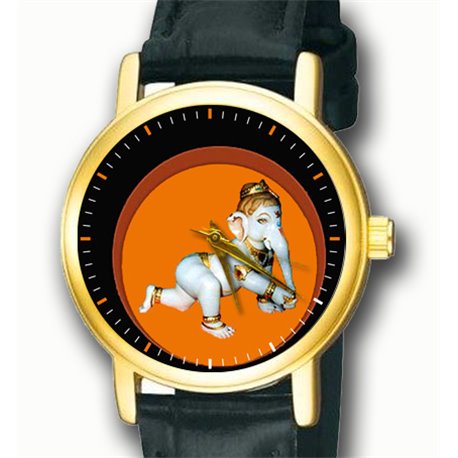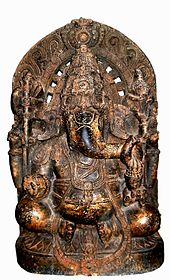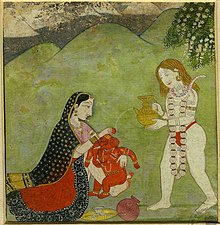No products
Religious Art
New products
-

Seth vs Osiris, Ancient Egypt Metallic Original Art Solid Brass Collectible Mens' Watch
40 mm solid brass casing in gold finish with stainless steel back...
$ 121.44 -

Chinese Traditional Good Luck Dragon Art Gold Medallion Solid Brass Men's Watch
40 mm solid brass casing in gold finish with stainless steel back...
$ 129.59 -

English Colours Fire-Breathing Dragon Ancient Parchment Fantasy Art Brass Watch
40 mm solid brass casing in gold finish with stainless steel back...
$ 137.74 -

Ancient Blue Fire-Breathing Dragon Parchment Art Solid Brass Mens Dress Watch
40 mm solid brass casing in gold finish with stainless steel back...
$ 137.74 -

Golden Dragon Metallic Art Solid Brass Collectible Men's Fantasy Good Luck Watch
40 mm solid brass casing in gold finish with stainless steel back...
$ 121.44
Beautiful Bal Ganesha Hinduism Religious Art Wrist Watch
REL-004
New product
- unisex 30 mm solid brass casing with stainless steel back
- premium 2040 quartz movement.
- original parchment art acrylic dial
- also available in bigger 40 mm size or in a chrome finish case (use "Contact Us" link)
- 1 year warranty
More info
Ganesha has many other titles and epithets, including Ganapati and Vighneshvara. The Hindu title of respect Shri (Sanskrit: श्री; IAST: śrī; also spelled Sri or Shree) is often added before his name. One popular way Ganesha is worshipped is by chanting a Ganesha Sahasranama, a litany of "a thousand names of Ganesha". Each name in the sahasranama conveys a different meaning and symbolises a different aspect of Ganesha. At least two different versions of the Ganesha Sahasranama exist; one version is drawn from the Ganesha Purana, a Hindu scripture venerating Ganesha.
The name Ganesha is a Sanskrit compound, joining the words gana (Sanskrit: गण; IAST: gaṇa), meaning a group, multitude, or categorical system and isha (Sanskrit: ईश; IAST: īśa), meaning lord or master. The word gaņa when associated with Ganesha is often taken to refer to the gaņas, a troop of semi-divine beings that form part of the retinue of Shiva (IAST: Śiva). The term more generally means a category, class, community, association, or corporation.[20] Some commentators interpret the name "Lord of the Gaņas" to mean "Lord of Hosts" or "Lord of created categories", such as the elements. Ganapati (Sanskrit: गणपति; IAST: gaṇapati), a synonym for Ganesha, is a compound composed of gaṇa, meaning "group", and pati, meaning "ruler" or "lord". The Amarakosha,[22] an early Sanskrit lexicon, lists eight synonyms of Ganesha : Vinayaka, Vighnarāja (equivalent to Vignesha), Dvaimātura (one who has two mothers), Gaṇādhipa (equivalent to Ganapatiand Ganesha), Ekadanta (one who has one tusk), Heramba, Lambodara (one who has a pot belly, or, literally, one who has a hanging belly), and Gajanana (IAST: gajānana); having the face of an elephant).
Vinayaka (Sanskrit: विनायक; IAST: vināyaka) is a common name for Ganesha that appears in the Purāṇas and in Buddhist Tantras. This name is reflected in the naming of the eight famous Ganesha temples in Maharashtra known as the Ashtavinayak (aṣṭavināyaka).[ The names Vighnesha (Sanskrit: विघ्नेश; IAST: vighneśa) and Vighneshvara (Sanskrit: विघ्नेश्वर; vighneśvara) (Lord of Obstacles) refers to his primary function in Hindu mythology as the master and remover of obstacles (vighna).
A prominent name for Ganesha in the Tamil language is Pille (Tamil: பிள்ளை) or Pillaiyar (பிள்ளையார்) (Little Child). A. K. Narain differentiates these terms by saying that pille means a "child" while pillaiyar means a "noble child". He adds that the words pallu, pella, and pell in the Dravidian family of languages signify "tooth or tusk", also "elephant tooth or tusk". Anita Raina Thapan notes that the root word pille in the name Pillaiyar might have originally meant "the young of the elephant", because the Pali word pillaka means "a young elephant".
In the Burmese language, Ganesha is known as Maha Peinne, derived from Pali Mahā Wināyaka. The widespread name of Ganesha in Thailand is Phra Phikhanet or Phra Phikhanesuan, both of which are derived from Vara Vighnesha and Vara Vighneshvara respectively, whereas the name Khanet (from Ganesha) is rather rare.
Iconography
Ganesha is a popular figure in Indian art.[32] Unlike those of some deities, representations of Ganesha show wide variations and distinct patterns changing over time.[33] He may be portrayed standing, dancing, heroically taking action against demons, playing with his family as a boy, sitting down or on an elevated seat, or engaging in a range of contemporary situations.
Ganesha images were prevalent in many parts of India by the 6th century.[34] The figure shown to the right is typical of Ganesha statuary from 900–1200, after Ganesha had been well-established as an independent deity with his own sect. This example features some of Ganesha's common iconographic elements. A virtually identical statue has been dated between 973–1200 by Paul Martin-Dubost,[35] and another similar statue is dated c. 12th century by Pratapaditya Pal.[36] Ganesha has the head of an elephant and a big belly. This statue has four arms, which is common in depictions of Ganesha. He holds his own broken tusk in his lower-right hand and holds a delicacy, which he samples with his trunk, in his lower-left hand. The motif of Ganesha turning his trunk sharply to his left to taste a sweet in his lower-left hand is a particularly archaic feature.[37] A more primitive statue in one of the Ellora Caves with this general form has been dated to the 7th century.[38] Details of the other hands are difficult to make out on the statue shown. In the standard configuration, Ganesha typically holds an axe or a goad in one upper arm and a noose in the other upper arm.
The influence of this old constellation of iconographic elements can still be seen in contemporary representations of Ganesha. In one modern form, the only variation from these old elements is that the lower-right hand does not hold the broken tusk but rather is turned toward the viewer in a gesture of protection or fearlessness (abhaya mudra).[39] The same combination of four arms and attributes occurs in statues of Ganesha dancing, which is a very popular theme.[40]
[edit]Common attributes
- For thirty-two popular iconographic forms of Ganesha, see Sritattvanidhi
Ganesha has been represented with the head of an elephant since the early stages of his appearance in Indian art.[42] Puranic myths provide many explanations for how he got his elephant head.[43] One of his popular forms, Heramba-Ganapati, has five elephant heads, and other less-common variations in the number of heads are known.[44] While some texts say that Ganesha was born with an elephant head, in most stories he acquires the head later.[45] The most recurrent motif in these stories is that Ganesha was created by Parvati using clay to protect her and Shiva beheaded him when Ganesha came between Shiva and Parvati. Shiva then replaced Ganesha's original head with that of an elephant.[46] Details of the battle and where the replacement head came from vary according to different sources.[47] In another story, when Ganesha was born, his mother, Parvati, showed off her new baby to the other gods. Unfortunately, the god Shani (Saturn), who is said to have the evil eye, looked at him, causing the baby's head to be burned to ashes. The god Vishnu came to the rescue and replaced the missing head with that of an elephant.[48] Another story says that Ganesha was created directly by Shiva's laughter. Because Shiva considered Ganesha too alluring, he gave him the head of an elephant and a protruding belly.[49]
Ganesha's earliest name was Ekadanta (One Tusked), referring to his single whole tusk, the other having been broken off.[50] Some of the earliest images of Ganesha show him holding his broken tusk.[51] The importance of this distinctive feature is reflected in the Mudgala Purana, which states that the name of Ganesha's second incarnation is Ekadanta.[52] Ganesha's protruding belly appears as a distinctive attribute in his earliest statuary, which dates to the Gupta period (4th to 6th centuries).[53] This feature is so important that, according to the Mudgala Purana, two different incarnations of Ganesha use names based on it: Lambodara (Pot Belly, or, literally, Hanging Belly) and Mahodara (Great Belly).[54] Both names are Sanskrit compounds describing his belly (IAST: udara).[55] The Brahmanda Purana says that Ganesha has the name Lambodara because all the universes (i.e., cosmic eggs; IAST: brahmāṇḍas) of the past, present, and future are present in him.[56] The number of Ganesha's arms varies; his best-known forms have between two and sixteen arms.[57] Many depictions of Ganesha feature four arms, which is mentioned in Puranic sources and codified as a standard form in some iconographic texts.[58] His earliest images had two arms.[59] Forms with 14 and 20 arms appeared in Central India during the 9th and 10th centuries.[60] The serpent is a common feature in Ganesha iconography and appears in many forms.[61]According to the Ganesha Purana, Ganesha wrapped the serpent Vasuki around his neck.[62] Other depictions of snakes include use as a sacred thread (IAST: yajñyopavīta)[63] wrapped around the stomach as a belt, held in a hand, coiled at the ankles, or as a throne. Upon Ganesha's forehead there may be a third eye or the Shaivite sectarian mark (IAST: tilaka), which consists of three horizontal lines.[64] The Ganesha Purana prescribes a tilaka mark as well as a crescent moon on the forehead.[65] A distinct form of Ganesha called Bhalachandra (IAST: bhālacandra; "Moon on the Forehead") includes that iconographic element.[66] Ganesha is often described as red in color.[67] Specific colors are associated with certain forms.[68]Many examples of color associations with specific meditation forms are prescribed in the Sritattvanidhi, a treatise on Hindu iconography. For example, white is associated with his representations as Heramba-Ganapati and Rina-Mochana-Ganapati(Ganapati Who Releases from Bondage).[69] Ekadanta-Ganapati is visualized as blue during meditation in that form.[70]
Vahanas
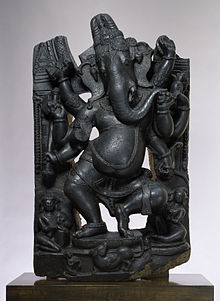
The earliest Ganesha images are without a vahana (mount/vehicle).[72] Of the eight incarnations of Ganesha described in the Mudgala Purana, Ganesha has a mouse (shrew) in five of them, uses a lion in his incarnation as Vakratunda, a peacock in his incarnation of Vikata, and Shesha, the divine serpent, in his incarnation as Vighnaraja.[73] Of the four incarnations of Ganesha listed in the Ganesha Purana,Mohotkata has a lion, Mayūreśvara has a peacock, Dhumraketu has a horse, and Gajanana has a mouse.[74] Jain depictions of Ganesha show his vahana variously as a mouse, elephant, tortoise, ram, or peacock.[75]
Ganesha is often shown riding on or attended by a mouse, shrew or rat.[76] Martin-Dubost says that the rat began to appear as the principal vehicle in sculptures of Ganesha in central and western India during the 7th century; the rat was always placed close to his feet.[77] The mouse as a mount first appears in written sources in the Matsya Purana and later in the Brahmananda Purana and Ganesha Purana, where Ganesha uses it as his vehicle only in his last incarnation.[78] The Ganapati Atharvashirsa includes a meditation verse on Ganesha that describes the mouse appearing on his flag.[79] The names Mūṣakavāhana (mouse-mount) and Ākhuketana (rat-banner) appear in the Ganesha Sahasranama.[80]
The mouse is interpreted in several ways. According to Grimes, "Many, if not most of those who interpret Gaṇapati's mouse, do so negatively; it symbolizes tamoguṇa as well as desire".[81] Along these lines, Michael Wilcockson says it symbolizes those who wish to overcome desires and be less selfish.[82] Krishan notes that the rat is destructive and a menace to crops. The Sanskrit word mūṣaka (mouse) is derived from the root mūṣ (stealing, robbing). It was essential to subdue the rat as a destructive pest, a type of vighna (impediment) that needed to be overcome. According to this theory, showing Ganesha as master of the rat demonstrates his function as Vigneshvara (Lord of Obstacles) and gives evidence of his possible role as a folk grāma-devatā (village deity) who later rose to greater prominence.[83] Martin-Dubost notes a view that the rat is a symbol suggesting that Ganesha, like the rat, penetrates even the most secret places.[84]
Associations
Obstacles

Ganesha is Vighneshvara or Vighnaraja or "Vighnaharta"(marathi), the Lord of Obstacles, both of a material and spiritual order.[85] He is popularly worshipped as a remover of obstacles, though traditionally he also places obstacles in the path of those who need to be checked. Paul Courtright says that "his task in the divine scheme of things, his dharma, is to place and remove obstacles. It is his particular territory, the reason for his creation."[86]
Krishan notes that some of Ganesha's names reflect shadings of multiple roles that have evolved over time.[27] Dhavalikar ascribes the quick ascension of Ganesha in the Hindu pantheon, and the emergence of the Ganapatyas, to this shift in emphasis from vighnakartā (obstacle-creator) to vighnahartā (obstacle-averter).[87] However, both functions continue to be vital to his character, as Robert Brown explains, "even after the Purāṇic Gaṇeśa is well-defined, in art Gaṇeśa remained predominantly important for his dual role as creator and remover of obstacles, thus having both a negative and a positive aspect".[88]
Buddhi (Knowledge)
Ganesha is considered to be the Lord of letters and learning.[89] In Sanskrit, the word buddhi is a feminine noun that is variously translated as intelligence, wisdom, or intellect.[90] The concept of buddhi is closely associated with the personality of Ganesha, especially in the Puranic period, when many stories stress his cleverness and love of intelligence. One of Ganesha's names in the Ganesha Purana and the Ganesha Sahasranama is Buddhipriya.[91] This name also appears in a list of 21 names at the end of the Ganesha Sahasranama that Ganesha says are especially important.[92] The word priya can mean "fond of", and in a marital context it can mean "lover" or "husband",[93] so the name may mean either "Fond of Intelligence" or "Buddhi's Husband".[94]
Aum
Ganesha is identified with the Hindu mantra Aum (Tamil:ஓம், Sanskrit:ॐ) also spelled Om). The term oṃkārasvarūpa (Aum is his form), when identified with Ganesha, refers to the notion that he personifies the primal sound.[95] The Ganapati Atharvashirsa attests to this association. Chinmayananda translates the relevant passage as follows:[96]
(O Lord Ganapati!) You are (the Trinity) Brahma, Vishnu, and Mahesa. You are Indra. You are fire [Agni] and air [Vāyu]. You are the sun [Sūrya] and the moon [Chandrama]. You are Brahman. You are (the three worlds) Bhuloka [earth], Antariksha-loka [space], and Swargaloka [heaven]. You are Om. (That is to say, You are all this).
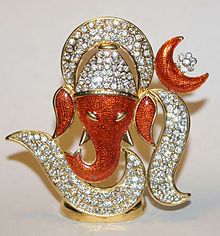
Some devotees see similarities between the shape of Ganesha's body in iconography and the shape of Aum in the Devanāgarī and Tamil scripts.[97]
First chakra
According to Kundalini yoga, Ganesha resides in the first chakra, called Muladhara (mūlādhāra). Mula means "original, main"; adhara means "base, foundation". The muladhara chakra is the principle on which the manifestation or outward expansion of primordial Divine Force rests.[98] This association is also attested to in the Ganapati Atharvashirsa. Courtright translates this passage as follows: "[O Ganesha,] You continually dwell in the sacral plexus at the base of the spine [mūlādhāra cakra]."[99] Thus, Ganesha has a permanent abode in every being at the Muladhara.[100] Ganesha holds, supports and guides all other chakras, thereby "governing the forces that propel the wheel of life".[98]
Family and consorts
Though Ganesha is popularly held to be the son of Shiva and Parvati, the Puranic myths give different versions about his birth.[102] He may have been created by Shiva,[103] or by Parvati,[104] or by Shiva and Parvati,[105] or appeared mysteriously and was discovered by Shiva and Parvati.[106]
The family includes his brother the war god Kartikeya, who is also called Subramanya, Skanda, Murugan and other names.[107] Regional differences dictate the order of their births. In northern India, Skanda is generally said to be the elder, while in the south, Ganesha is considered the first born.[108] In northern India, Skanda was an important martial deity from about 500 BCE to about 600 CE, when worship of him declined significantly in northern India. As Skanda fell, Ganesha rose. Several stories tell of sibling rivalry between the brothers[109] and may reflect sectarian tensions.[110]
Ganesha's marital status, the subject of considerable scholarly review, varies widely in mythological stories.[111] One pattern of myths identifies Ganesha as an unmarried brahmacari.[112] This view is common in southern India and parts of northern India.[113] Another pattern associates him with the concepts of Buddhi (intellect), Siddhi (spiritual power), and Riddhi (prosperity); these qualities are sometimes personified as goddesses, said to be Ganesha's wives.[114] He also may be shown with a single consort or a nameless servant (Sanskrit: daşi).[115] Another pattern connects Ganesha with the goddess of culture and the arts, Sarasvati or Śarda (particularly in Maharashtra).[116] He is also associated with the goddess of luck and prosperity, Lakshmi.[117] Another pattern, mainly prevalent in the Bengal region, links Ganesha with the banana tree, Kala Bo.[118]
The Shiva Purana says that Ganesha had two sons: Kşema (prosperity) and Lābha (profit). In northern Indian variants of this story, the sons are often said to be Śubha (auspiciouness) and Lābha.[119] The 1975 Hindi film Jai Santoshi Maa shows Ganesha married to Riddhi and Siddhi and having a daughter named Santoshi Ma, the goddess of satisfaction. This story has no Puranic basis, but Anita Raina Thapan and Lawrence Cohen cite Santoshi Ma's cult as evidence of Ganesha's continuing evolution as a popular deity.[120]
Worship and festivals
Ganesha is worshipped on many religious and secular occasions; especially at the beginning of ventures such as buying a vehicle or starting a business.[121] K.N. Somayaji says, "there can hardly be a [Hindu] home [in India] which does not house an idol of Ganapati. [..] Ganapati, being the most popular deity in India, is worshipped by almost all castes and in all parts of the country".[122] Devotees believe that if Ganesha is propitiated, he grants success, prosperity and protection against adversity.[123]
Ganesha is a non-sectarian deity, and Hindus of all denominations invoke him at the beginning of prayers, important undertakings, and religious ceremonies.[124] Dancers and musicians, particularly in southern India, begin performances of arts such as the Bharatnatyam dance with a prayer to Ganesha.[125] Mantras such as Om Shri Gaṇeshāya Namah (Om, salutation to the Illustrious Ganesha) are often used. One of the most famous mantras associated with Ganesha is Om GaṃGanapataye Namah (Om, Gaṃ, Salutation to the Lord of Hosts).[126]
Devotees offer Ganesha sweets such as modaka and small sweet balls (laddus).[127] He is often shown carrying a bowl of sweets, called a modakapātra.[128] Because of his identification with the color red, he is often worshipped with red sandalwood paste (raktacandana)[129] or red flowers. Dūrvā grass (Cynodon dactylon) and other materials are also used in his worship.[130]
Festivals associated with Ganesh are Ganesh Chaturthi or Vināyaka chaturthī in the śuklapakṣa (the fourth day of the waxing moon) in the month of bhādrapada (August/September) and the Gaṇeśa jayanti (Gaṇeśa's birthday) celebrated on thecathurthī of the śuklapakṣa (fourth day of the waxing moon) in the month of māgha (January/February)."[131]Ganesh Chaturthi

An annual festival honours Ganesha for ten days, starting on Ganesh Chaturthi, which typically falls in late August or early September.[132] The festival begins with people bringing in clay idols of Ganesha, symbolising Ganesha's visit. The festival culminates on the day of Ananta Chaturdashi, when idols (murtis) of Ganesha are immersed in the most convenient body of water.[133] Some families have a tradition of immersion on the 3rd, 5th, or 7th day. In 1893, Lokmanya Tilak transformed this annual Ganesha festival from private family celebrations into a grand public event.[134] He did so "to bridge the gap between the Brahmins and the non-Brahmins and find an appropriate context in which to build a new grassroots unity between them" in his nationalistic strivings against the British in Maharashtra.[135] Because of Ganesha's wide appeal as "the god for Everyman", Tilak chose him as a rallying point for Indian protest against British rule.[136] Tilak was the first to install large public images of Ganesha in pavilions, and he established the practice of submerging all the public images on the tenth day.[137] Today, Hindus across India celebrate the Ganapati festival with great fervour, though it is most popular in the state of Maharashtra.[138][139] The festival also assumes huge proportions in Mumbai, Pune, and in the surrounding belt of Ashtavinayaka temples. This festival is also most popular in Goa and is celebrated for 1-1/2 day, 5 days and 7 days.
Temples
Ganesh is the first god for getting puja in all yagas. In Hindu temples, Ganesha is depicted in various ways: as an acolyte or subordinate deity (pãrśva-devatã); as a deity related to the principal deity (parivāra-devatã); or as the principal deity of the temple (pradhāna), treated similarly as the highest gods of the Hindu pantheon.[140] As the god of transitions, he is placed at the doorway of many Hindu temples to keep out the unworthy, which is analogous to his role as Parvati’s doorkeeper.[141] In addition, several shrines are dedicated to Ganesha himself, of which the Ashtavinayak (Sanskrit: अष्टविनायक; aṣṭavināyaka; lit. "eight Ganesha (shrines)") in Maharashtra are particularly well known. Located within a 100-kilometer radius of the city of Pune, each of these eight shrines celebrates a particular form of Ganapati, complete with its own lore and legend.[142] The eight shrines are: Morgaon, Siddhatek, Pali, Mahad, Theur, Lenyadri, Ozar and Ranjangaon.
There are many other important Ganesha temples at the following locations: Wai in Maharashtra; Ujjain in Madhya Pradesh; Jodhpur, Nagaur and Raipur (Pali) in Rajasthan; Baidyanath in Bihar; Baroda, Dholaka, and Valsad in Gujarat and Dhundiraj Temple in Varanasi, Uttar Pradesh. Prominent Ganesha temples in southern India include the following: Kanipakam in Chittoor; the Jambukeśvara Temple at Tiruchirapalli; at Rameshvaram and Suchindram; Karpaka Vinayakar Temple in Tamil Nadu; at Malliyur,Kottarakara, Pazhavangadi, Kasargod in Kerala, Hampi, and Idagunji in Karnataka; and Bhadrachalam in Andhra Pradesh.[143][144]
T. A. Gopinatha notes, "Every village however small has its own image of Vighneśvara (Vigneshvara) with or without a temple to house it in. At entrances of villages and forts, below pīpaḹa (Sacred fig) trees [...], in a niche [...] in temples of Viṣṇu (Vishnu) as well as Śiva (Shiva) and also in separate shrines specially constructed in Śiva temples [...]; the figure of Vighneśvara is invariably seen."[145] Ganesha temples have also been built outside of India, including southeast Asia, Nepal (including the fourVinayaka shrines in the Kathmandu valley), and in several western countries.
Rise to prominence
First appearance
Ganesha appeared in his classic form as a clearly recognizable deity with well-defined iconographic attributes in the early 4th to 5th centuries.[148] Shanti Lal Nagar says that the earliest known iconic image of Ganesha is in the niche of the Shiva temple at Bhumra, which has been dated to the Gupta period.[149] His independent cult appeared by about the 10th century.[148] Narain summarizes the controversy between devotees and academics regarding the development of Ganesha as follows:[150]
[W]hat is inscrutable is the somewhat dramatic appearance of Gaņeśa on the historical scene. His antecedents are not clear. His wide acceptance and popularity, which transcend sectarian and territorial limits, are indeed amazing. On the one hand there is the pious belief of the orthodox devotees in Gaņeśa's Vedic origins and in the Purāṇic explanations contained in the confusing, but nonetheless interesting, mythology. On the other hand there are doubts about the existence of the idea and the icon of this deity" before the fourth to fifth century A.D. ... [I]n my opinion, indeed there is no convincing evidence of the existence of this divinity prior to the fifth century.
Possible influences
Courtright reviews various speculative theories about the early history of Ganesha, including supposed tribal traditions and animal cults, and dismisses all of them in this way:[151]
In this search for a historical origin for Gaņeśa, some have suggested precise locations outside the Brāhmaṇic tradition.... These historical locations are intriguing to be sure, but the fact remain
Reviews
No customer reviews for the moment.


